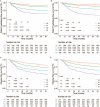The evolution of the nasopharyngeal carcinoma staging system over a 10-year period: implications for future revisions
- PMID: 32810045
- PMCID: PMC7478675
- DOI: 10.1097/CM9.0000000000000978
The evolution of the nasopharyngeal carcinoma staging system over a 10-year period: implications for future revisions
Abstract
Background: The classification criteria and staging groups for nasopharyngeal carcinoma described in the Union for International Cancer Control/American Joint Committee on Cancer (UICC/AJCC) staging system have been revised over time. This study assessed the proportion of patients whose staging and treatment strategy have changed due to revisions of the UICC/AJCC staging system over the past 10 years (ie, from the sixth edition to the eighth edition), to provide information for further refinement.
Methods: We retrospectively reviewed 1901 patients with non-metastatic nasopharyngeal carcinoma treated in our cancer center between November 2009 and June 2012. The Akaike information criterion and Harrell concordance index were applied to evaluate the performance of the staging system.
Results: In total, 25 (1.3%) of the 1901 patients who were staged as T2a according to the sixth edition system were downgraded to T1 in the eighth edition; 430 (22.6%) staged as N0 in the sixth edition were upgraded to N1 in the eighth edition; 106 (5.6%) staged as N1/2 in the sixth edition were upgraded to N3 in the eighth edition. In addition, 51 (2.7%) and 25 (1.3%) of the study population were upstaged from stage I to stage II and stage II to stage IVa, respectively; 10 (0.5%) was downgraded from stage II to stage I. The survival curves of adjacent N categories and staging groups defined by eighth classification system were well-separated. However, there was no significant difference in the locoregional failure-free survival (P = 0.730) and disease-free survival (P = 0.690) rates between the T2 and T3 categories in the eighth edition classification system.
Conclusions: Modifications to the tumor-node-metastasis staging system over the past 10 years have resulted in N classification changes in numerous cases. Although the eighth edition tumor-node-metastasis staging system better predicts survival outcomes, the T classification could be simplified in future revisions.
Conflict of interest statement
None.
Figures



References
-
- Lo KW, To KF, Huang DP. Focus on nasopharyngeal carcinoma. Cancer Cell 2004; 5:423–428.. doi: 10.1016/s1535-6108(04)00119-9. - PubMed
-
- King AD, Vlantis AC, Bhatia KS, Zee BC, Woo JK, Tse GM, et al. Primary nasopharyngeal carcinoma: diagnostic accuracy of MR imaging versus that of endoscopy and endoscopic biopsy. Radiology 2011; 258:531–537.. doi: 10.1148/radiol.10101241. - PubMed
-
- Gordin A, Golz A, Daitzchman M, Keidar Z, Bar-Shalom R, Kuten A, et al. Fluorine-18 fluorodeoxyglucose positron emission tomography/computed tomography imaging in patients with carcinoma of the nasopharynx: diagnostic accuracy and impact on clinical management. Int J Radiat Oncol Biol Phys 2007; 68:370–376.. doi: 10.1016/j.ijrobp.2006.12.028. - PubMed
-
- Adams S, Baum RP, Stuckensen T, Bitter K, Hor G. Prospective comparison of 18F-FDG PET with conventional imaging modalities (CT, MRI, US) in lymph node staging of head and neck cancer. Eur J Nucl Med 1998; 25:1255–1260.. doi: 10.1007/s002590050293. - PubMed
-
- Kim MR, Roh JL, Kim JS, Lee JH, Cho KJ, Choi SH, et al. Utility of 18F-fluorodeoxyglucose positron emission tomography in the preoperative staging of squamous cell carcinoma of the oropharynx. Eur J Surg Oncol 2007; 33:633–638.. doi: 10.1016/j.ejso.2007.02.016. - PubMed
MeSH terms
LinkOut - more resources
Full Text Sources
Miscellaneous

